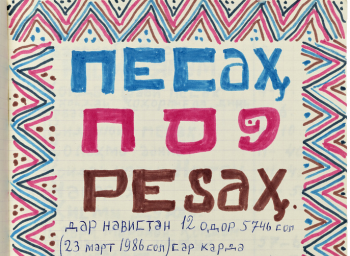Crossroads & Connections: Prayer and Persecution
By The National Library of Israel
Published Apr 26, 2023

Manuscript Siddur in Cyrillic Characters, Uzbekistan, 1986

>>> Expand this image. <<<
In the 1980s, Jewish activists in the Soviet Union began to conduct underground Hebrew classes and even acquired a limited quantity of prayer books. But several generations had never been taught the Hebrew language, and when younger people felt a need to pray, they could not read the traditional liturgy. One solution was for a more knowledgeable community member to borrow one of the few prayer books, copy it by hand, and add Cyrillic transliteration (the alphabet used by many Slavic people) and vernacular translation. Such is the background of this 1986 manuscript prayer book from Tashkent, Uzbekistan, with a Bukharan translation—written just a few years before the Soviet Union was dissolved and Jewish communal organizations were allowed to reopen.
The deeply traditional Bukharan Jewish community, steeped in Jewish practice and the local dialect of Judeo-Persian, faced a deep crisis with the rise of Communism in the region in 1920. While these Jews held a profound commitment to tradition, observance, and Scripture, the Soviet regime persecuted religion in general and Judaism in particular. It was primarily older community members, who had grown up without Soviet control, who held on to knowledge of Hebrew and Judaism, and, under these circumstances, continued to preserve the ancient and medieval tradition of the Jewish manuscript late into the modern period.
Prayer book in Cyrillic, Volume 2, non-numbered title page, Ms. Heb. 28° 7357.
The item may be protected by copyright. Use of the items is in accordance with Section 27A of the Israeli Copyright Law, 5768-2007, “Works for which the copyright owner is unknown or has not been located” (an “Orphan Work”). The National Library of Israel conducted a diligent search for the purpose of locating the copyright owner(s) as stipulated in Section 27A(a)(1) of the Copyright Law, but did not succeed in locating the copyright owner(s). If you are the owner or have additional information regarding ownership of copyright of the item, please contact us to assist in locating the copyright owners.
Photography by Ardon Bar-Hama.
Founded in Jerusalem in 1892, the National Library of Israel (NLI) serves as Israel's preeminent research library
Reflections
Click here to visit the exhibition resource page to learn more and to browse accompanying lesson plans, webinars, and videos, about the treasures in this exhibition.
Want more?
Get curated JewishArts.org content in your inbox


